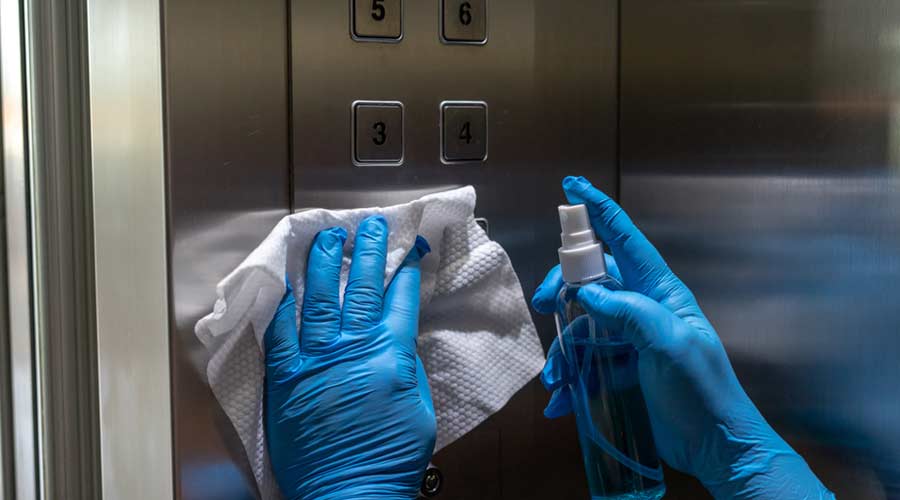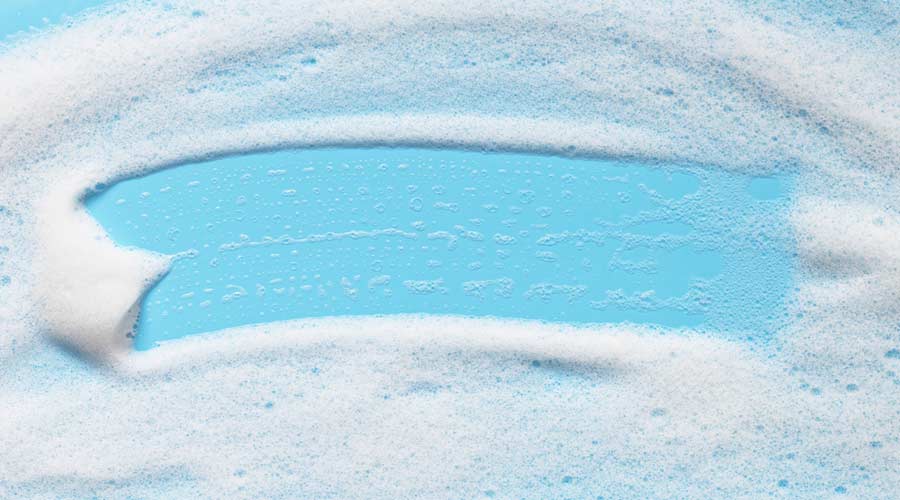
By Steve Ashkin and Allen Rathey
While “do no harm” is the Hippocratic Oath doctors take, it is well known that prescriptions that help one condition may create or aggravate others. Likewise, the well-meaning prescription for microfiber cleaning cloths and mops as part of a green cleaning program has had side effects.
Microfiber cloths and floor pads have become fixtures in the commercial cleaning industry, widely praised for their ability to trap dirt and remove bacteria with minimal use of water or chemicals. Marketed as cost-effective, high-performing, and eco-friendly, microfiber has gained rapid adoption in schools, office buildings, healthcare facilities, and other public spaces.
Yet behind this glowing reputation is a growing set of concerns. From microplastic pollution to inventory loss, inconsistent laundering practices, and misleading product claims, microfiber presents a series of unintended consequences that are often overlooked. As commercial cleaning companies strive to become more sustainable, it is crucial to reexamine microfiber’s real-world impacts.
Environmental Side Effects
Perhaps the most significant unintended consequence of microfiber is its role in contributing to microplastic contamination. Microfiber products are typically made from synthetic materials — polyester and polyamide — that shed microscopic plastic fibers each time they are laundered.
These fibers are too small to be captured by most wastewater treatment systems and ultimately end up in oceans, rivers, and even the air.
While microfiber is often promoted as environmentally preferable because of its reusability and reduced need for cleaning chemicals, this narrative ignores its long-term impact on ecosystems and public health (inhaling or ingesting microfiber is associated with lung disease; airway problems; forms of cancer; liver, gut, and kidney ailments; and the smallest fibers may enter the bloodstream, placenta, brain and other tissues).
Ironically, a product introduced to support green cleaning goals is now recognized as a key source of plastic pollution, highlighting the unintended environmental and public health costs of widespread microfiber use.
Misleading Marketing and Lack of Standards
The commercial cleaning market is saturated with microfiber products claiming to remove 99 percent of bacteria, last for hundreds of washes, and reduce the need for disinfectants. However, the industry suffers from a lack of uniform technical standards, leaving end users with few tools to verify these claims.
This absence of third-party verification means buyers may invest in microfiber products that underperform or deteriorate quickly, undermining both cleaning quality and cost efficiency. Without clear performance benchmarks or labeling standards, companies often discover — after implementation — that the products don’t meet expectations. This is another case of unintended consequences: in seeking better hygiene and sustainability, companies may end up with inconsistent results and greater long-term expenses.
Operational Issues: Shrinkage and Labor Burdens
A commonly overlooked challenge with microfiber is the issue of shrinkage — not in size, but in inventory. Microfiber cloths and pads are frequently lost, thrown out by accident, or taken home by employees who mistake them for personal items. These losses drive up replacement costs and disrupt cleaning operations.
In smaller companies without centralized laundry facilities, another problematic practice has emerged: requiring employees to wash microfiber at home. While this might seem like a practical solution, it introduces several unintended and problematic consequences:
• Cross-contamination risks: Microfiber cloths used to clean restrooms, public surfaces, or healthcare areas are washed in the same machines as personal clothing, increasing the risk of microbial transfer.
• Inconsistent laundering: Improper machine washing, fabric softeners and detergents can shorten the lifespan of the cloths and reduce cleaning performance.
• Uncompensated employee costs: Workers are asked to donate time, water, energy, and appliance use to support their employers — often without compensation or clear guidelines. This raises concerns about labor fairness and liability.
These are prime examples of well-meaning policies that lead to unintended burdens for employees and diminished cleaning quality for facilities.
The Illusion of Sustainability
Microfiber products are often seen as a more sustainable option due to their reusability and ability to reduce chemical usage. However, when considering the full lifecycle — from production (which relies on fossil fuels) to disposal (where microfiber items are not recyclable and may persist in landfills for decades) — the sustainability story becomes much more complicated.
The hidden environmental costs, including microplastic release and petroleum-based inputs, can quickly outweigh the supposed benefits. What begins as an eco-friendly strategy may ultimately become a greenwashing pitfall unless purchasing decisions are based on complete lifecycle assessments and transparent data.
Macro Leadership in Micro Pollution
While “microfibers [are] the most prominent form of microplastics in the environment,” per a 2023 review in Science of the Total Environment, the cleaning industry is a relatively small contributor to the problem driven largely by consumer textiles, clothing, furnishings, and laundering.
Still, professionals in the cleaning industry need to do their part, take responsibility, and act for the greater good — as many did and are doing, by adopting green cleaning, reducing harmful chemicals and unsustainable practices.
Showing macro leadership in reducing micro[fiber] pollution, jan/san professionals can choose improvements to — or innovate replacements for — these materials and processes, and make a difference:
A 2021 report in Environmental Science and Pollution Research stated that “the use of finer count yarns with filaments and compact structures reduces microfiber shedding...[and that] a proper production method and parameter will yield a textile that sheds lesser or no microfiber.”
Transparency, Innovation, and Accountability
The rise of microfiber in commercial cleaning is a textbook case of unintended consequences emerging from innovation without adequate oversight. To move forward, the industry needs a more thoughtful, evidence-based approach:
• Convert “microfiber” from a marketing term to a technical term.
• Establish technical standards to ensure consistent product performance, such as meeting a shedding test like TM212-2021, “Test Method for Fiber Fragment Release During…Laundering” from the American Association of Textile Chemists and Colorists (AATCC), or another test. Google “microfiber shedding tests” for more information.
• Require third-party validation of environmental and antimicrobial claims.
• Since laundering microfiber and other textiles is the main source of microplastics release per a 2024 Environmental Pollution report — “Release of microplastic fibers from synthetic textiles during…washing” — adopt gentler methods of laundering to limit agitation and fiber release. For example, consider manually pre-soaking and rinsing soiled microfiber cloths in cold water.
• Add filters to washing machines to capture released fibers.
• Add more robust filters to dryers.
• Wash microfiber separately without fabric softener to prevent clogging the fibers and use mesh bags to contain microfiber and reduce fiber break-down. Also avoid bleach and high-pH detergents which break down fibers.
• Air or tumble dry on low heat (~104 degrees Fahrenheit or 40 degrees Celsius) and consider using drying racks rather than dryers.
• Educate cleaning professionals and purchasers about the real costs — environmental, operational, and human — of microfiber use.
Issues with Alternatives
Some experts have suggested returning to the use of cotton cloths, but even organic cotton is often dyed and treated for durability. It would also require a huge amount of land and water to meet the need, and reduced cleaning performance may increase cleaning chemical usage.
Meanwhile, disposable paper wipes often contain plastic fibers like polyester that don’t biodegrade and add to microplastic pollution.
Then there are bioplastics. While lowering petroleum use, bioplastics may contain the same chemical additives as traditional plastics and contribute to microplastic pollution. The study, "Are Biobased Microfibers Less Harmful than Conventional Plastic Microfibers..." published in the November 5, 2024, issue of Environmental Science & Technology said: "A key concern for the environmental risk assessment of biobased plastics is whether they present a greater hazard than conventional polymers used in equivalent applications."
Microfiber products were introduced with the promise of improving hygiene and sustainability. In many ways, they delivered — but not without a host of unforeseen impacts. From microplastic contamination to labor concerns and product mismanagement, the commercial cleaning industry must now grapple with the unintended consequences of microfiber’s widespread use.
As sustainability and public health continue to drive change in the cleaning sector, it’s time to demand transparency, embrace innovation, and develop solutions that truly align with environmental and ethical goals — and to the extent possible, do no harm.
Steve Ashkin is the president of The Ashkin Group. He is considered the “Father of Green Cleaning” and has been recognized by ISSA as one of the most influential members of the cleaning industry over the past 100 years. He can be reached at Steve@AshkinGroup.com.
Allen Rathey is an educator focused on Healthy Facilities who collaborates with experts that share his passion for safe, healthy indoor environments. He is Director of the Indoor Health Council (IHC) and founder of the nonprofit Indoor Exposure Index. He can be reached at allen@indoorhealthcouncil.org.
posted on 7/8/2025

 The Down and Dirty on Cleaning in Virus Season
The Down and Dirty on Cleaning in Virus Season How Surfactant Use is Expanding in Commercial Cleaning
How Surfactant Use is Expanding in Commercial Cleaning